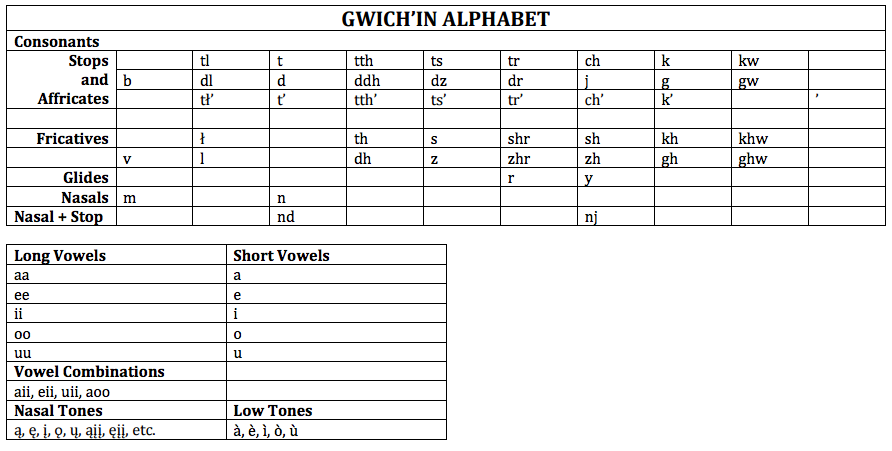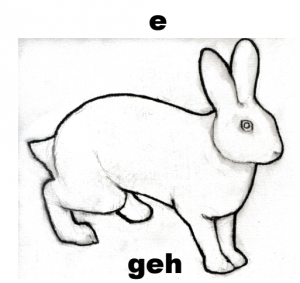The following material can be referred to throughout this course.
Alphabet

Download this Gwich’in Alphabet sheet (PDF)
Using the Alphabet on Your Computer
In order to type in special Gwich’in characters (like Å‚, aÌ€, ęįį, etc.) you will need to install the Gwich’in keyboard layout. Go to Language Geek – Athabascan Keyboard Layouts and find the ‘Windows Download‘ under ‘Alaska Athebascan’ and follow their instructions on how to install it. If you use a Mac, go a little further down the page and click on the NWT Athabascan ‘Mac Download‘ and follow the instructions for Mac installation. Each section has a pdf available for the keyboard layout that you can also print out for reference.
Sounds Overview
Gwich’in Listening Exercise #1 by Hishinlai’ Peter:
Special Characters
In Gwich’in there are some unique symbols and sounds that English speakers may not be familiar with.
The “Bar L’ or “Indian L” which is represented by this symbol: Å. The Å sound is made by putting the tip of one’s tongue to the roof of the mouth and pushing the air out of both sides of the mouth to make an air rushing sound like in the video below.
“Glottal Stop’ which is represented by an apostrophe like in the word “Gwich’in’. The glottal stop is another sound that will be unfamiliar to English speakers, but is very prevalent in Gwich’in, so much so it is even in the word Gwich’in! The glottal stop is basically a pause initiated in the back of the throat, basically cutting the syllable off by stopping the air. It almost sounds like Gwich/in. There is a very brief pause there.
To get a better understanding of how the bar L, glottal stop, and other consonants sound, listen to the videos and try to repeat the sounds made.
Tone
Some Athabascan languages are tonal languages, which mean that the way a person’s voice rises or falls when saying certain speech sounds influences the meaning of the word being spoken. Tone is indicated by marks that appear above vowels. There are four types of tone that appear to varying degrees in Athabascan languages. They are indicated as follows:
Tone in Athabascan Languages
| High Tone | Low Tone | Falling Tone | Rising Tone |
| á | à | â | ǎ |
| Voice rises when saying sound | Voice falls when saying sound | Voice rises then falls when saying sound | Voice falls then rises when saying sound |
The use of tone differs across Athabascan languages. For example, Tanacross has high tone, rising and falling, whereas in Ahtna there is no use of tone.
Nasals
Another important feature in some Athabascan languages, such as Gwich’in, is the use of the nasal. A nasal is a hook-like mark that is placed under a vowel or vowels that indicates the sound is to be produced through the nose and mouth, not just the mouth.
| Nasal | Nasal |
| ą | ęįį |
| Sound is made through the nose and mouth | Sound is made through the nose and mouth |
For example, nasals can be seen in the words “ihłįi’ meaning “I am‘, and “(place) gwihch’įį’, meaning “I live (at a place)‘.
